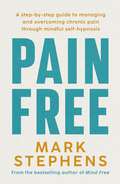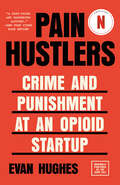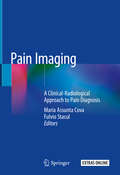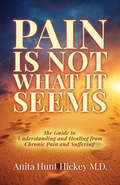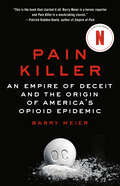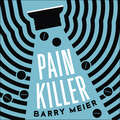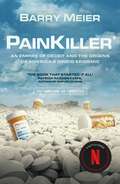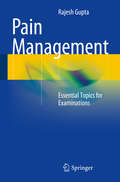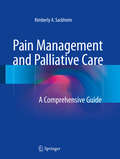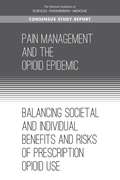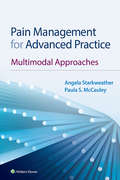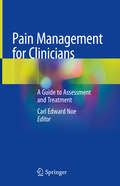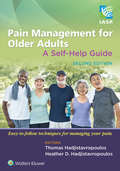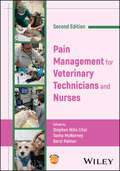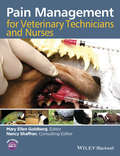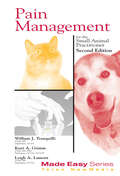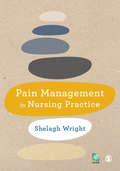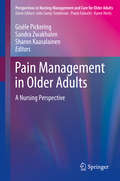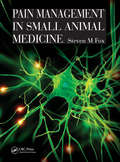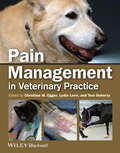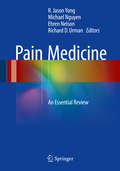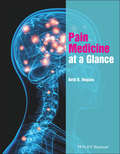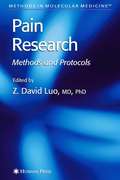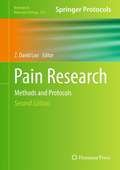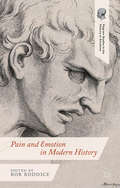- Table View
- List View
Pain Free: The easy four-step method to reduce pain naturally
by Mark StephensFOUR EASY STEPS TO NATURALLY MANAGE PAINMark Stephens, often called the Hypnotic Healer, developed the techniques in this book over the past three decades while helping thousands of individuals suffering from pain - and he can help you too.Chronic pain affects one in five adults, impacting mental health and overall quality of life. Despite trying various methods for relief, many people continue to live with pain every day. There is hope - a solution that lieswithin the power of your mind. Research has shown we can flip the pain switch off and tap into a wonderful DOSE of Happy Healing Hormones.Mark's easy-to-follow Four-Step Pain-Free Method can be practised by anyone. Within these pages, you'll discover a proven combination of breathing exercises, meditation techniques, self-hypnosis scripts and memorable mantras, making it possible to manage and reduce emotional, acute and chronic pain. And don't worry if you think you can't be hypnotised or can't meditate, Mark has that covered.Pain Free is a simple step-by-step guide designed to help you navigate and overcome pain. This book aims to support you on your journey toward a healthier, happier and pain-free life. 'I am amazed by the simplicity of the four steps you teach within Pain Free. I have witnessed the results firsthand, and while it may seem like magic, there is a science behind these easy-to-learn techniques. Anyone who takes the time to read this book will surely experience a noticeable reduction in pain.' Debbie Graham, Registered NurseBy using this approach, you can discover how to gently soothe away your pain for good.Includes BONUS guided online sessions with Mark Stephens - QR code to access inside book
Pain Hustlers: Crime and Punishment at an Opioid Startup Originally published as The Hard Sell
by Evan HughesThe inside story of a band of entrepreneurial upstarts who made millions selling painkillers—until their scheme unraveled, putting them at the center of a landmark criminal trial. • SOON TO BE THE MAJOR MOTION PICTURE PAIN HUSTLERS STARRING EMILY BLUNT AND CHRIS EVANS "Unfolds with the velocity and verve of a Scorsese film…A tour de force."—Patrick Radden Keefe, New York Times bestselling author of Empire of Pain and Say Nothing John Kapoor had already amassed a small fortune in pharmaceuticals when he founded Insys Therapeutics. It was the early 2000s, a boom time for painkillers, and he developed a novel formulation of fentanyl, the most potent opioid on the market. Kapoor, a brilliant immigrant scientist with relentless business instincts, was eager to make the most of his innovation. He gathered around him an ambitious group of young lieutenants. His head of sales—an unstable and unmanageable leader, but a genius of persuasion—built a team willing to pull every lever to close a sale, going so far as to recruit an exotic dancer ready to scrape her way up. They zeroed in on the eccentric and suspect doctors receptive to their methods. Employees at headquarters did their part by deceiving insurance companies. The drug was a niche product, approved only for cancer patients in dire condition, but the company&’s leadership pushed it more widely, and together they turned Insys into a Wall Street sensation. But several insiders reached their breaking point and blew the whistle. They sparked a sprawling investigation that would lead to a dramatic courtroom battle, breaking new ground in the government&’s fight to hold the drug industry accountable in the spread of addictive opioids. In Pain Hustlers, National Magazine Award–finalist Evan Hughes lays bare the pharma playbook. He draws on unprecedented access to insiders of the Insys saga, from top executives to foot soldiers, from the patients and staff of far-flung clinics to the Boston investigators who treated the case as a drug-trafficking conspiracy, flipping cooperators and closing in on the key players. With colorful characters and true suspense, Pain Hustlers offers a bracing look not just at Insys, but at how opioids are sold at the point they first enter the national bloodstream—in the doctor&’s office.
Pain Imaging: A Clinical-Radiological Approach to Pain Diagnosis
by Maria Assunta Cova Fulvio StaculThis book addresses all pain imaging aspects related to both the central nervous system and the body (thorax, abdomen and pelvis), thus updating the international literature on the topic.By adopting a clinical-radiological approach and offering a comprehensive differential diagnosis for a number of painful syndromes (many of which can mimic one other), the work aims to support and enhance the diagnostic management of these patients, suggesting the most appropriate diagnostic algorithm. The book is divided into separate sections for each anatomical macro-area, and the chapters cover the respective topics from both clinical and radiological perspectives. Further, the book includes extensive electronic supplementary material. As such, it offers an invaluable tool for radiologists, neuroradiologists and clinicians working in internal medicine, surgery and neurology, and could also be used in residency programs for these groups.
Pain Is Not What It Seems: The Guide to Understanding and Healing from Chronic Pain and Suffering
by Anita Hunt HickeyPain is Not What it Seems contains a treasure trove of scientific references supporting an astonishingly simple and transformative path to healing and well-being. While conventional Western medicine tends to treat the body and mind as separate entities, scientific evidence proves that physical, spiritual, and psychological aspects of self can affect one another on a profound level. Pain Is Not What It Seems explains the science that tells us that only when these deeper spiritual and emotional issues are addressed can true healing from suffering and pain begin. After thirty years treating military and civilian patients with chronic and acute pain and associated disorders, Dr. Hickey has shared profound wisdom and insights of the “secrets” behind how to heal from intractable complex pain, which—although published in scientific journals and books—is not taught to most doctors nor found in standard wellness curriculums. Her astonishingly simple and transformative program provides an easy-to-follow path to healing from suffering and pain that reaffirms what those suffering realize intrinsically: they are a whole person and need to be treated as such.
Pain Killer: An Empire of Deceit and the Origin of America's Opioid Epidemic
by Barry Meier“Groundbreaking . . . the shocking account of the origins of today's opioid epidemic, the creators of this plague, and the way to help stop it.”—Sam Quinones, author of Dreamland: The True Tale of America’s Opiate Epidemic“Prescient . . . a landmark work of investigative journalism.”—David A. Kessler, former commissioner of the Food and Drug Administration and author of The End of Overeating Between 1999 and 2017, an estimated 250,000 Americans died from overdoses involving prescription painkillers, a plague ignited by Purdue Pharma’s aggressive marketing of OxyContin. Families, working class and wealthy, have been torn apart, businesses destroyed, and public officials pushed to the brink. In Pain Killer, Pulitzer Prize–winning New York Times reporter Barry Meier exposes the roots of the most pressing health epidemic of the twenty-first century. Powerful narcotic painkillers, or opioids, were once used as drugs of last resort for pain sufferers. Purdue turned OxyContin into a billion-dollar blockbuster by launching an unprecedented marketing campaign claiming that the drug’s long-acting formulation made it safer to use than traditional painkillers for many types of pain. That illusion was quickly shattered as drug abusers learned that crushing an Oxy could release its narcotic payload all at once. Even in its prescribed form, Oxy proved fiercely addictive. As OxyContin’s use and abuse grew, Purdue concealed what it knew from regulators, doctors, and patients. Here are the people who profited from the crisis and those who paid the price, those who plotted in boardrooms and those who tried to sound alarm bells. A country doctor in rural Virginia, Art Van Zee, took on Purdue and warned officials about OxyContin abuse. An ebullient high school cheerleader, Lindsey Myers, was reduced to stealing from her parents to feed her escalating Oxy habit. A hard-charging DEA official, Laura Nagel, tried to hold Purdue executives to account. The drugmaker’s owners, Raymond and Mortimer Sackler, whose names adorn museums worldwide, made enormous fortunes from the commercial success of OxyContin. In this updated edition of Pain Killer, Barry Meier breaks new ground in his decades-long investigation into the opioid epidemic. He takes readers inside Purdue to show how long the company withheld information about the abuse of OxyContin and gives a shocking account of the Justice Department’s failure to alter the trajectory of the opioid epidemic and protect thousands of lives. Equal parts crime thriller, medical detective story, and business exposé, Pain Killer is a hard-hitting look at how a supposed wonder drug became the gateway drug to a national tragedy.
Pain Killer: An Empire of Deceit and the Origins of America's Opioid Epidemic
by Barry MeierSoon to be a major Netflix seriesEvery catastrophe has a beginning. For the opioid crisis in America, the seed was a drug called OxyContin. First hailed as a miracle drug for severe pain in the early 1990s, OxyContin went on to ignite a plague of addiction and death across America, fuelled by the aggressive marketing of its maker, Purdue Pharma and the billionaire Sackler brothers who owned the company.Investigative journalist Barry Meier was the first to write about the elusive Sackler family, their role in this catastrophic epidemic and the army of local doctors, law enforcement and worried parents that tried to bring them down. We meet Lindsay Meyers, proud of being the youngest Oxy user she knows at just 16, local doctor Art Van Zee who witnesses his community in the grip of a ferocious epidemic, the three billionaire Sackler brothers, and Laura Nagel, the government official who made it her mission to hold the company to account.Equal parts crime thriller, medical detective story, and business exposé, Pain Killer is the origin story of the opioid crisis, a hard-hitting look at how a supposed wonder drug became the trigger for a national tragedy.(P) 2020 Penguin Random House Audio
Pain Killer: An Empire of Deceit and the Origins of America's Opioid Epidemic
by Barry MeierEvery catastrophe has a beginning. For the opioid crisis in America, the seed was a drug called OxyContin. First hailed as a miracle drug for severe pain in the early 1990s, OxyContin went on to ignite a plague of addiction and death across America, fuelled by the aggressive marketing of its maker, Purdue Pharma and the billionaire Sackler brothers who owned the company.Investigative journalist Barry Meier was the first to write about the elusive Sackler family, their role in this catastrophic epidemic and the army of local doctors, law enforcement and worried parents that tried to bring them down. We meet the teenager proud of being the youngest Oxy user she knows at just 16, the local doctor who witnesses his community in the grip of a ferocious epidemic, the three billionaire Sackler brothers, and the government official who made it her mission to hold the company to account.Equal parts crime thriller, medical detective story, and business exposé, Pain Killer is the origin story of the opioid crisis and a hard-hitting look at how a supposed wonder drug became the trigger for a national tragedy.
Pain Management
by Rajesh GuptaPain management is a vast subject and is changing rapidly. Finding a good resource for learning, however, is difficult. This book covers the entire curriculum relating to pain management and will make it easy to learn all aspects of the subject by covering key concepts in a reader-friendly manner. It comprises nine concise and simple chapters that aim to impart the maximum information within a limited space. These chapters address anatomy, assessment of pain, diagnosis of pain, pharmacology, non-pharmacological pain management, acute and chronic pain management, pain management in special groups, and special techniques. Pain Management: Essential Topics for Examinations will be an ideal resource for those who plan to sit for examinations, wherever they are based in the world. In addition, it will be an invaluable reference for higher and advanced pain trainees, residents, and physicians working in chronic pain.
Pain Management and Palliative Care
by Kimberly A. SackheimThis comprehensive book covers the knowledge needed to diagnosis and treat patients with acute and chronic pain. Sections dedicated to patient evaluation, medication management, treating patients with more complex circumstances and interventional management provide clinically-relevant information on an array of topics relevant to both the generalist and specialist. Some sections being organized in a diagnosis based approach help to focus on these topics and serve as a quick reference. A practical and easy-to-use guide, Pain Management and Palliative Care provides a broad foundation on pain assessment and management and is an invaluable daily companion for those managing patients experiencing pain.
Pain Management and the Opioid Epidemic: Balancing Societal And Individual Benefits And Risks Of Prescription Opioid Use
by Engineering Medicine National Academies of SciencesDrug overdose, driven largely by overdose related to the use of opioids, is now the leading cause of unintentional injury death in the United States. The ongoing opioid crisis lies at the intersection of two public health challenges: reducing the burden of suffering from pain and containing the rising toll of the harms that can arise from the use of opioid medications. Chronic pain and opioid use disorder both represent complex human conditions affecting millions of Americans and causing untold disability and loss of function. In the context of the growing opioid problem, the U.S. Food and Drug Administration (FDA) launched an Opioids Action Plan in early 2016. As part of this plan, the FDA asked the National Academies of Sciences, Engineering, and Medicine to convene a committee to update the state of the science on pain research, care, and education and to identify actions the FDA and others can take to respond to the opioid epidemic, with a particular focus on informing FDA's development of a formal method for incorporating individual and societal considerations into its risk-benefit framework for opioid approval and monitoring.
Pain Management for Advanced Practice: Multimodal Approaches
by Angela Starkweather Paula S. McCauleyHandle the vital issue of pain management safely and effectively, with the proven range of treatments offered in Pain Management for Advanced Practice. Offering compassionate, holistic pain management strategies — pharmacological and nonpharmacological — this expert guide supports evidence-based decision making, with multimodal care options that include cognitive behavioral therapy, yoga, acupuncture, analgesics and supplementary pharmaceuticals. Essential for clinicians in all practice areas, this is the real-world support all advanced practice clinicians need for managing patients in pain.
Pain Management for Clinicians: A Guide to Assessment and Treatment
by Carl Edward NoeThis book focuses on the modern clinical management of acute and chronic pain syndromes. It not only presents information in a clinically illuminating format, but in a manner that is cognizant of the current prescription opioid epidemic. Divided into seven sections, this book covers acute pain, common pain conditions, regional pain problems, interdisciplinary evaluation and treatment, medical treatments and pain in different stages of life. Concluding with the exploration of several special topics, the last section includes an important discussion on the regulatory and legal issues in the use of controlled substances. Chapters are concise and relevant, with an emphasis on treatment based upon evidence from clinical trials and interpretation by practitioners in the field. Expertly written text is further supplemented by high-quality figures, images and tables outlining proven treatments with drug, dose or other information describing details of treatment. Timely, informative, and socially conscious, Pain Management for Clinicians: A Guide to Assessment and Treatment is a valuable reference for clinicians who manage patients with chronic and common pain problems.
Pain Management for Older Adults: A Self-help Guide
by Thomas Hadjistavropoulos Heather HadjistavropoulosWritten specifically for older adults who need practical information and advice for managing chronic pain, this easy-to-read, illustrated guide offers effective techniques, exercises, and methods to improve quality of life. With an emphasis on realistic goals, resisting negative thoughts, and mind/body balance, this Second Edition of Pain Management for Older Adults: A Self-Help Guide offers an up-to-date approach to successful pain management, ideal for older adults with chronic pain, physicians and health-care providers, and caregivers.
Pain Management for Veterinary Technicians and Nurses
by Tasha McNerney Darci Palmer Stephen Niño CitalA practical guide for veterinary technicians and nurses on essential concepts of animal pain management Pain management is an essential aspect of medical care, but in the field of veterinary medicine it poses unique challenges. Learning to recognize animal pain, to advocate for patient care, and to build and implement pain management protocols allows veterinary nursing teams to be more effective and vastly improves patient outcomes. Mastering this aspect of veterinary medicine means developing an understanding of pain physiology and pharmacology of pain management drugs, the necessity of various analgesics in different care environments, and how to tackle obstacles to animal pain care. Pain Management for Veterinary Technicians and Nurses, 2nd edition provides a robust update to the only textbook on this subject directed at veterinary technicians in the US. Already a standard text for its coverage of small companion animals, this book now also covers analgesic techniques in horses, lab animals, and zoo species, making it a valuable resource for technicians in a range of professional and clinical situations. Updated to incorporate the latest evidence-based medicine, it promises to continue as the essential introduction to this oft-overlooked but critical dimension of veterinary medicine. Pain Management for Veterinary Technicians and Nurses readers will also find: Multiple expanded chapters as well as a new chapter covering pain management for c-sections and neonatal careA new emphasis on critical thinking and a holistic approach to patient careCoverage of complementary and alternative therapiesExpanded illustrations of regional analgesia techniques Pain Management for Veterinary Technicians and Nurses is a valuable guide for veterinary technicians in both general and specialized anesthetic practice, as well as veterinary students and general veterinary practitioners.
Pain Management for Veterinary Technicians and Nurses
by Nancy Shaffran Mary Ellen GoldbergPain Management for Veterinary Technicians and Nurses guides readers through the important concepts of animal pain management, providing specific approaches to managing pain in a wide variety of veterinary conditions. Emphasizing the technician's role in advocating for the patient, the book equips technicians with the knowledge needed to manage pain in dogs, cats, horses, livestock, exotics, and zoo animals. Logically and comprehensively covering this difficult subject, Pain Management for Veterinary Technicians and Nurses provides both introductory material on the tenets of pain management and specific techniques to apply in the clinical setting.With information on recognizing and understanding pain, the physiology of pain, pharmacology, and analgesia in different settings, the book outlines how to practice good pain management as an integral part of nursing care. Pain Management for Veterinary Technicians and Nurses provides both basic and advanced information, allowing students, practicing veterinary technicians and nurses, and veterinary staff alike to take a more active role in pain management and develop a more thorough understanding of this complex subject.
Pain Management for the Small Animal Practitioner (Book+CD)
by Kurt A. Grimm William J. Tranquilli Leigh A. LamontThis manual provides an easy guide to pain management for the veterinary practitioner. Beginning with pain terminology, it goes on to describe to physiology of pain, management strategies, various drugs and techniques, and the management of specific conditions and procedures. Strategies for the treatment of pain are reviewed, with an overview of the mechanisms by which pain is perceived and the principles of pain management. The drugs used in the treatment of acute and chronic pain are discussed as well as the specific techniques used to control intra- and post operative pain in dogs and cats. Published by Teton New Media USA and distributed by CRC Press outside of North America.
Pain Management in Nursing Practice
by Shelagh WrightPain is a challenging area to understand for any healthcare professional, and quality training on the subject is required if nurses are to provide effective pain management and person-centred care. Based on the curriculum developed by the International Association for the Study of Pain, this book offers an essential guide to managing pain. Beginning with an examination of the biology of pain, it then goes on to consider pain management across the life course, looking at key topics including acute pain, cancer pain and pharmacology. Case scenarios are included throughout the book to help readers apply the knowledge they have learned to their own practice. This book is aimed primarily at meeting the learning needs of undergraduate nurses, and is essential reading for all healthcare professionals studying pain. The text will be helpful as a basic foundation for more advanced postgraduate courses in pain management in nursing practice.
Pain Management in Older Adults: A Nursing Perspective (Perspectives in Nursing Management and Care for Older Adults)
by Gisèle Pickering Sandra Zwakhalen Sharon KaasalainenThis book addresses relevant issues to enhance pain management nurses need to advocate for effective pain treatment in the elderly. Significant changes in the evolving nursing and healthcare environment require adequate information on this topic, as pain is a very challenging area. As other care professionals, nurses are daily confronted with issues on pain assessment and management. This volume offers an overview within an evolving health environment, in which nurses dealing with pain play a growing role. It showcases best practices in pain assessment and management, details non pharmacological and pharmacological treatments. It also addresses core issues defined by the International Association for the Study of Pain (IASP), such as knowledge translation, that are most relevant for clinical nurses, student nurses, nurse researchers as well as other care professionals.
Pain Management in Small Animal Medicine
by Steven FoxPain Management in Small Animal Medicine describes and clearly illustrates the difficulties and choices facing veterinarians in identifying and treating pain, in addition to providing an account of the neurobiological mechanisms responsible for the pain. Expanded from the author's previous work, Chronic Pain in Small Animal Medicine, this volume us
Pain Management in Veterinary Practice
by Lydia Love Tom Doherty Christine M. EggerPain Management in Veterinary Practice provides veterinary practitioners with the information needed to recognize and manage pain in a wide range of large, small, and exotic animal species. Encompassing acute, adaptive, and chronic, maladaptive pain, the book provides an up-to-date review of the physiology and pathophysiology of pain. Pain Management in Veterinary Practice offers specific strategies for addressing pain in animals, including local and regional analgesia, continuous rate infusions, and novel methods of analgesic drug delivery.With comprehensive information on the pharmacokinetic and pharmacodynamic characteristics of analgesic drugs, the book goes beyond pharmaceutical options to incorporate scientific information on techniques for complementary treatment, including physical therapy, acupuncture, chiropractic techniques, and nutritional strategies. Pain Management in Veterinary Practice is a valuable resource for developing pain management protocols in the veterinary clinic.
Pain Medicine
by Richard D. Urman R. Jason Yong Michael Nguyen Ehren NelsonThis text is a primary review for the written pain medicine board examination. It presents important clinical entities while covering critical pain medicine concepts. Chapters are brief and follow a common format to facilitate quick look-up. Each chapter in Pain Medicine includes a concise discussion of the latest supporting evidence as well as case scenarios. The coverage is clinically and board relevant and up-to-date appealing to residents preparing for the written board examination and practitioners preparing for re-certification, which occurs every 10 years. Beyond these groups, the book has the potential to appeal to learners and practitioners around the world; pain medicine is burgeoning globally, and there is great need for concise, clinically relevant resources.
Pain Medicine at a Glance (At a Glance)
by Beth B. HogansPain Medicine at a Glance The market-leading at a Glance series is popular among healthcare students and newly qualified practitioners for its concise, simple approach and excellent illustrations. Each bite-sized chapter is covered in a double-page spread with clear, easy-to-follow diagrams, supported by succinct explanatory text. Covering a wide range of topics, books in the at a Glance series are ideal as introductory texts for teaching, learning and revision, and are useful throughout university and beyond.Everything you need to know about Pain Medicine... at a Glance! Pain Medicine at a Glance is a user-friendly, visual introduction to the impact of pain in various clinical care settings, focusing on primary care needs. Aligned with learning objectives developed by the Johns Hopkins School of Medicine, this authoritative guide covers the basic forms and pathophysiology of pain, the clinical skills necessary for delivering excellent care, pharmacological and non-pharmacological treatments, and a variety of special cases such as healthcare ethics, integrative care, and treatment planning for chronic pain self-management therapy and the management of pain in children and older adults. A new addition to the market-leading at a Glance series, the text offers concise and accessible chapters, full-color illustrations, self-assessment questions, and easy-to-follow diagrams. Topics include pain assessment, cognitive factors that influence pain, applying behavioral perspectives on pain, managing opioids and other pharmacological therapies, treating acute pain in patients with substance abuse issues, and more. Perfect for learning, revision, and teaching, this book: Provides a foundation of clinical and basic science knowledge about pain and its mechanisms Describes major forms of pain, including surgical, orofacial, musculoskeletal, and obstetric pain Offers advice on fostering empathy and compassionate practices in pain medicine Covers non-pharmacological treatments such as physical therapy, hydrotherapy, meditation, acupuncture, massage, and various focal treatments Includes discussion of recent advances and new discoveries in pain science Pain Medicine at a Glance is the ideal companion for medical and healthcare students, junior doctors, advanced practice providers, nurse practitioners, and others involved in diagnosing and treating pain-associated illness. For more information on the complete range of Wiley medical student and junior doctor publishing, please visit: www.wiley.com To receive automatic updates on Wiley books and journals, join our email list. Sign up today at www.wiley.com/email All content reviewed by students for students Wiley Medical Education books are designed exactly for their intended audience. All of our books are developed in collaboration with students. This means that our books are always published with you, the student, in mind. If you would like to be one of our student reviewers, go to www.reviewmedicalbooks.com to find out more. This book is also available as an e-book. For more details, please see www.wiley.com/buy/9781118837665
Pain Research
by Z. David LuoA cutting-edge collection of diverse readily reproducible techniques for dissecting the molecular mechanisms of pain transduction. These methods employ a variety of multidisciplinary approaches ranging from animal pain models and single neutron selection to in vitro single-cell mRNA amplification. The collection includes not only standard and cutting-edge methods, but also novel techniques only recently applied to pain research. The protocols follow the successful Methods in Molecular BiologyTM series format, each one offering step-by-step laboratory instructions, an introduction outlining the principle behind the technique, lists of equipment and reagents, and tips on troubleshooting and avoiding known pitfalls.
Pain Research, 2nd Edition
by Z. David LuoThe advancements of medical technology, improvements in medical care, and increased patients’ life span make pain research and related drug development high priorities for both the research community and pharmaceutical companies. Rapid development of basic science research tools, such as techniques of flurometric labeling, genomic and proteomic high throughput screening, and genetically modified animals, promotes the swift acceleration of pain research to a stage allowing integrated investigations of pain processing mechanisms at the single cell and/or molecule level, and in a spatially and temporally controlled manner. Using multidisciplinary approaches, we can dissect the complicity of the sensory circuits connecting peripheral stimulation to maladaptive changes in the sensory pathways as well as pain perceptions at the central nervous system. Pain Research: Methods and Protocols, Second Edition provides advanced techniques and animal models that are critical for integrated pain research. Written in the highly successful Methods in Molecular Biology™ series format, chapters contain introductions to their respective topics, lists of the necessary materials and reagents, step-by-step, readily reproducible laboratory protocols, and notes on troubleshooting and avoiding known pitfalls.<P><P> Authoritative and accessible, Pain Research: Methods and Protocols, Second Edition serves as an ideal guide to novice pain researchers who may not have extensive experiences in the field, or to experienced pain researchers who would like to expand their research in new directions and/or to new mechanisms in different models.
Pain and Emotion in Modern History
by Rob BoddiceDrawing on the expertise of historical, literary and philosophical scholarship, practicing physicians, and the medical humanities this is a true interdisciplinary collaboration, styled as a history. It explores pain at the intersection of the living, suffering body, and the discursive cultural webs that entangle it in its specific moment.
